
THE CORNUCOPIA
OM ZUIKO's on E-1 BODY
8mm to 500mm samples for your perusal

THE CORNUCOPIA OM ZUIKO's on E-1 BODY 8mm to 500mm samples for your perusal |
|
OM ZUIKO LENSES ON OTHER OLYMPUS D-SLR's Before reading this article I'd like to draw you attention to other articles on this website that test many OM Zuiko lenses on various E-System bodies: OM ZUIKO LENSES ON E-330 16mm to 400mm. OM ZUIKO LENSES TESTED WITH DANDELION AF ADAPTER ON E-3. OM ZUIKO LENSES ON E-P1 (DIGITAL PEN) 8mm to 600mm.
INTRODUCTION Like all others coming from an OM background and buying into the Olympus 4/3rd system, I was immensely curious to see for myself how the OM Zuiko's performed on the new digital body. Reading the instruction sheet that accompanied the OM to 4/3rds adapter it seemed Olympus were hedging their bets. Whilst most OM lenses can be used there are more DONT's than DO's and the zooms that I'd taken a lot of time collecting seem doomed. My unfortunate experience trying to work my way around a wayward E-1 body and kit lens lost me many months; time I could have spent doing some comparative testing. Never mind - it's resolved now and I'm trying to catch up. Today I set the tripod up in the front garden and hefted out most of my prime lenses to couple up to the E-1. This is no mean task. I spent the whole afternoon and, honestly, I didn't enjoy myself at all............... Starting with the 8mm Fisheye and ending with the 500mm Zuiko Mirror I restricted myself to one shot per 'slow' lens (wide open) and two with the faster or longer ones. This 'frugal' approach has still led to over 40 shots to label up and re-size - and I kid you not when I say I certainly didn't enjoy that! I've also shot about 15 with two ZD's ranging from (equivalent) 28mm to 400mm for direct focal length comparison later. The day was pretty cloudy and overcast and I tried to avoid taking shots when the sun occassionally popped out. The images are centred on a small target that becomes obvious at around 35mm. The tripod was not moved during the testing session. E-1 has the same settings as in other testing sessions, the mirror-up feature is activated at 3 seconds and the remote control is used to trip the shutter. Output is SHQ jpeg. In addition some compensation was applied; please see 'RECOMMENDATIONS' at the foot of this page. The distance from E-1 CCD to the target is 100 feet. The images below have not been altered in any way other than labeling and re-sizing for the web. When I undertook a similar session last year there's no way I could have posted the results without substantial PS work. Anyone wanting full size versions for detailed analysis please contact me. The poor state of my lawn indicates what a dry summer we are having in UK. I haven't needed to cut the grass for over six weeks now. It looks terrible! ~~~~~~~~~~FISHEYE AND SUPER WIDE ANGLE - 8MM TO 24MM~~~~~~~~~~ | |
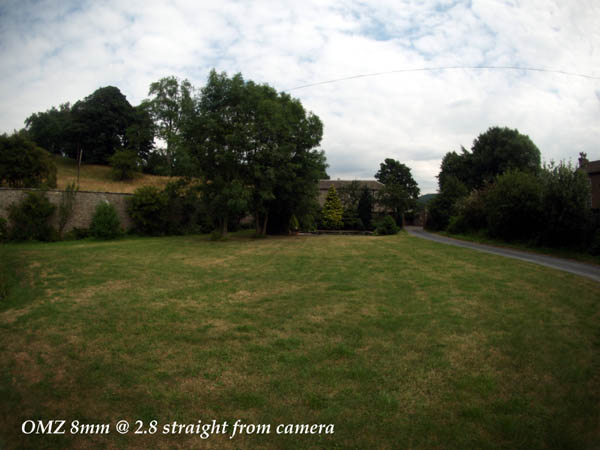
8mm Fisheye - there is evidence of light fall-off, but less than I'd anticipated. Fun only. The image is not circular. Better results are possible with practice. Not really practical. | |
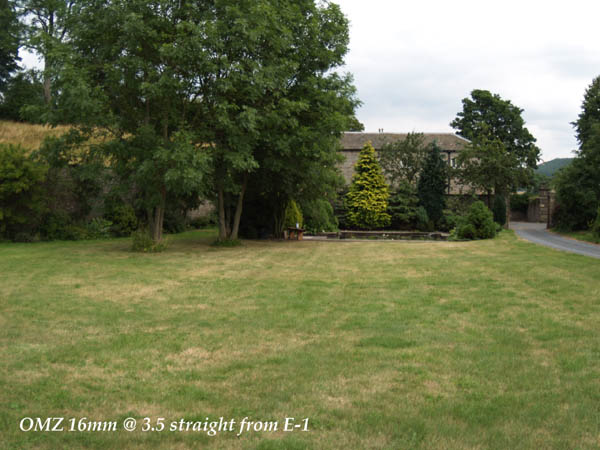
16mm Fisheye - equivalent of 32mm. This is eminently useable. This shot is wide open and the colours are pretty true. | |
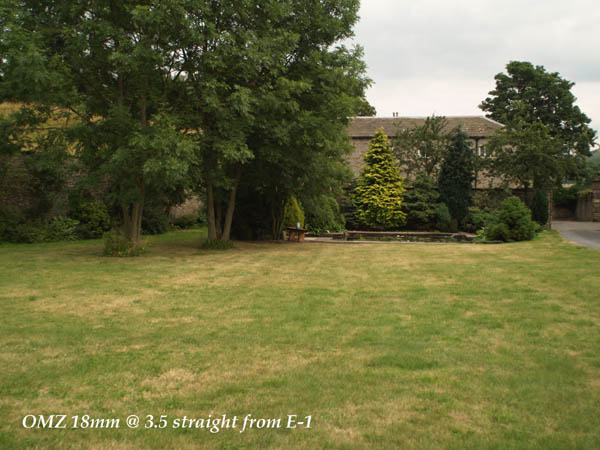
18mm SWA - very useable but watch that front element. Needs a tulip hood fitting. Slight colour variance but not dramatic. | |
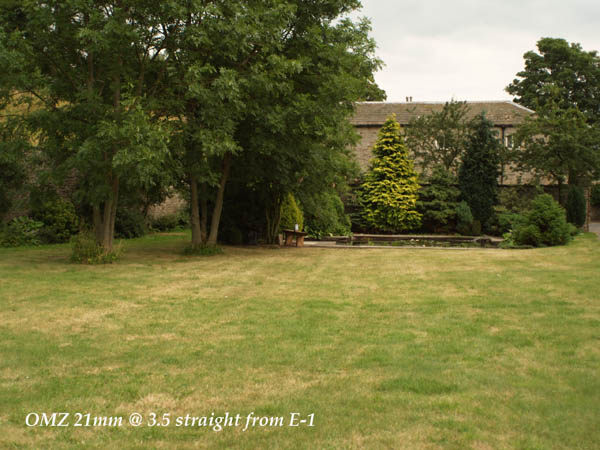
The slower 21mm - excellent, lightweight, nice. (Mine is a silvernose. I don't have the f2.0.) Recommended. | |
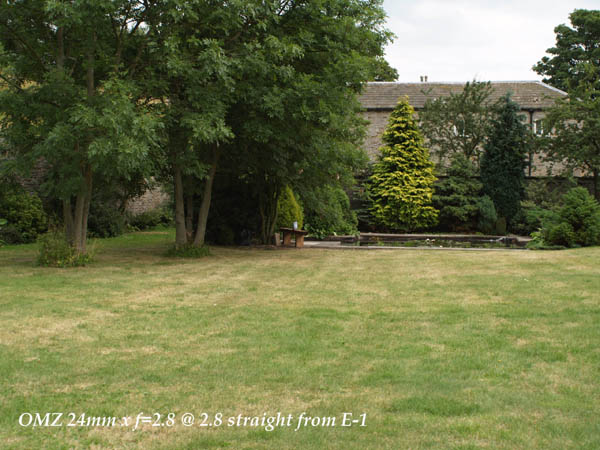
One of my favourites, the slower 24mm. Makes a good manual 'standard' lens. Highly recommended. | |
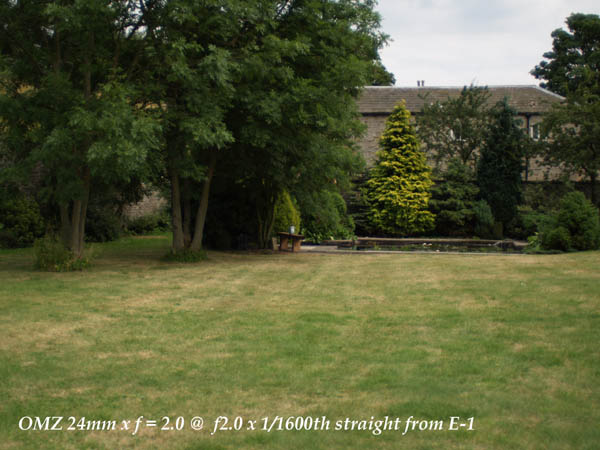
The faster f2.0 x 24mm. With E-1 fast does not mean good. Soft wide open. I've noticed too that faster versions are very prone to CA. | |
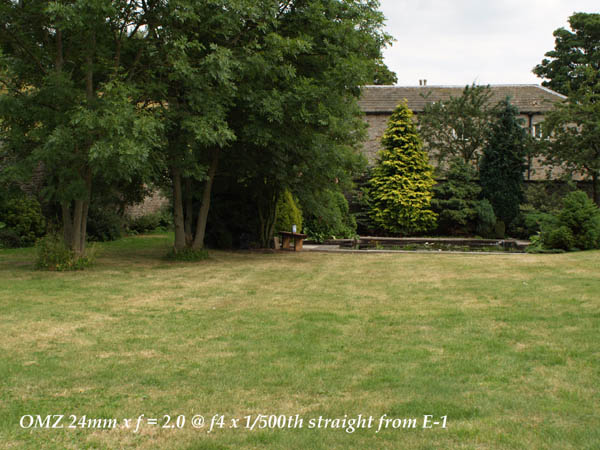
Sharpens up as you close the aperture; no where near as good as the 2.8 version. ~~~~~~~~~~~~~~WIDE ANGLE - 28MM TO 35MM~~~~~~~~~~~~~~ | |
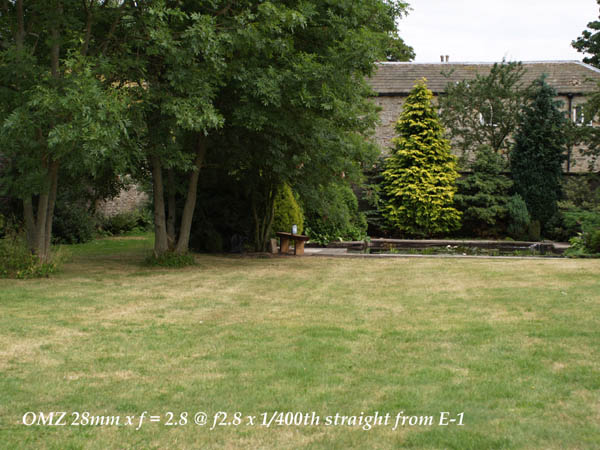
Not bad but it does tend to be soft. I've noticed quite a bit of CA with the 28mm x 2.8. | |
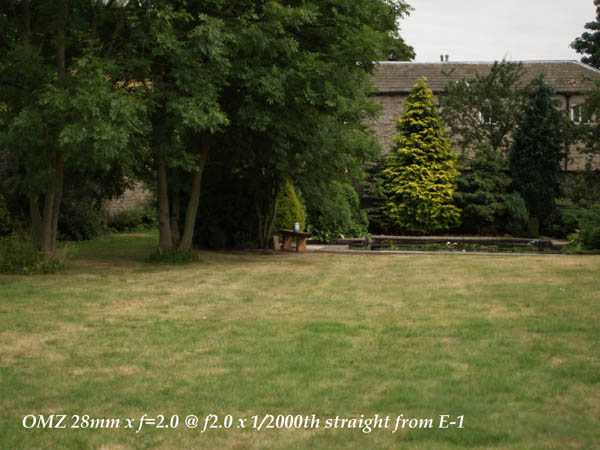
Not good. Soft as hell and full of CA. | |
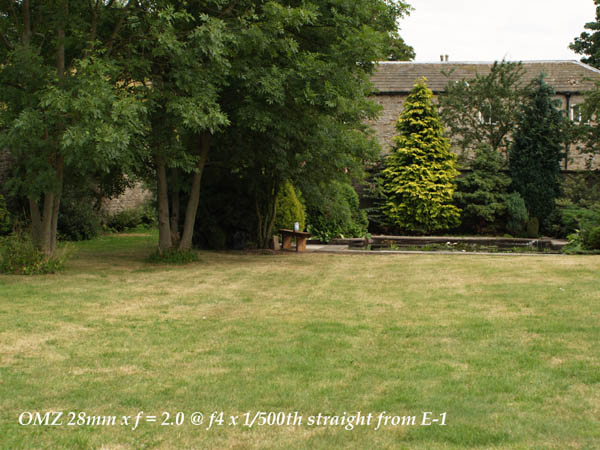
Better, but I'd avoid all the 28's if I were you. | |
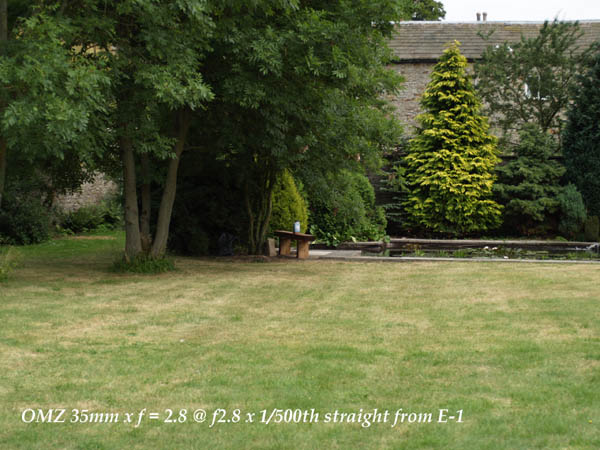
Generally better than the 28mm but not as good as the 24mm. If you need a 70mm it's OK. | |
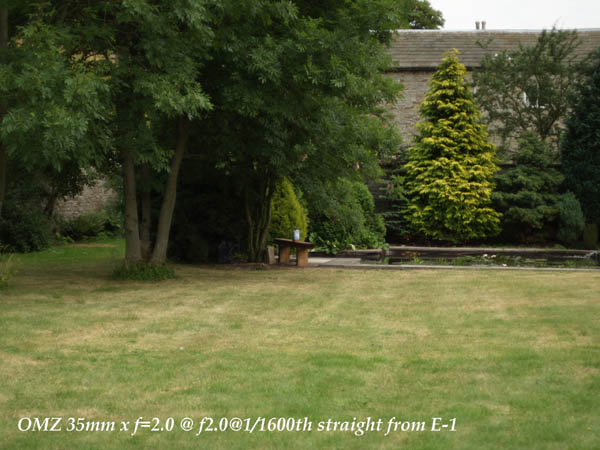
Soft to very soft. | |
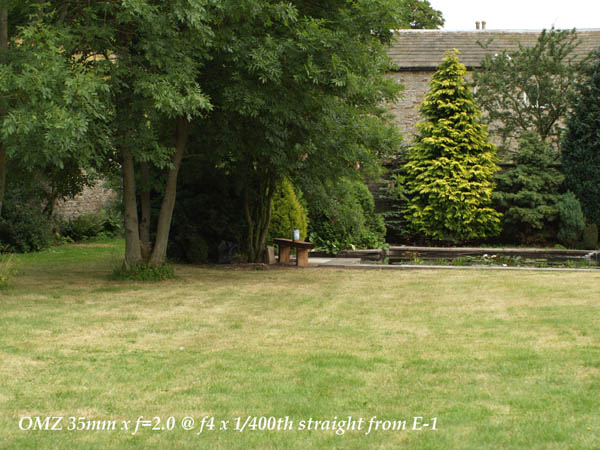
It's sharper and brighter, but not worth the weight penalty. ~~~~~~~~~~~~~~STANDARD - 40MM TO 55MM~~~~~~~~~~~~~~ | |
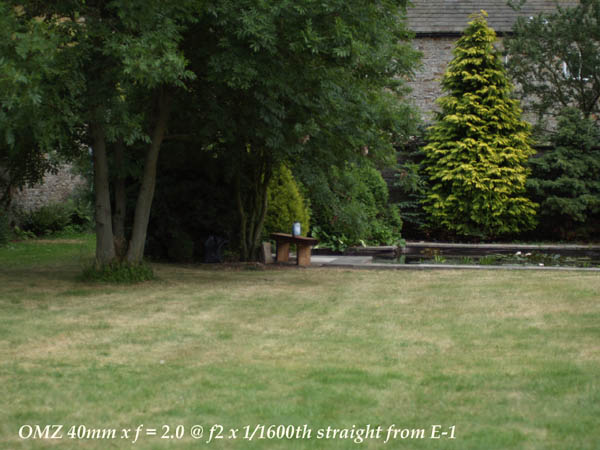
When I first tested the 40mm last year the results seemed good. This is poor wide open. | |
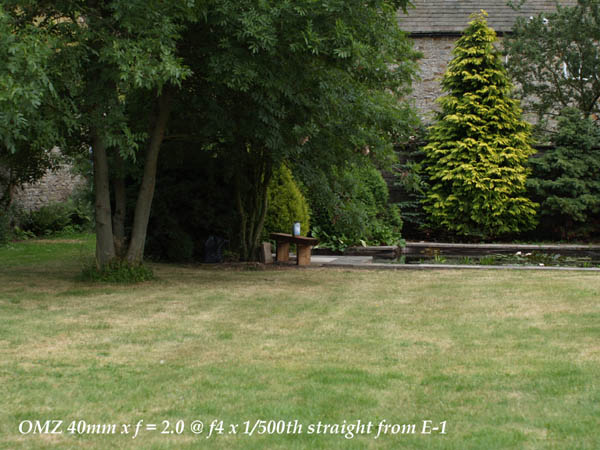
Better but not inspiring. I'm disappointed. Perhaps it might make a pancake portrait lens. | |
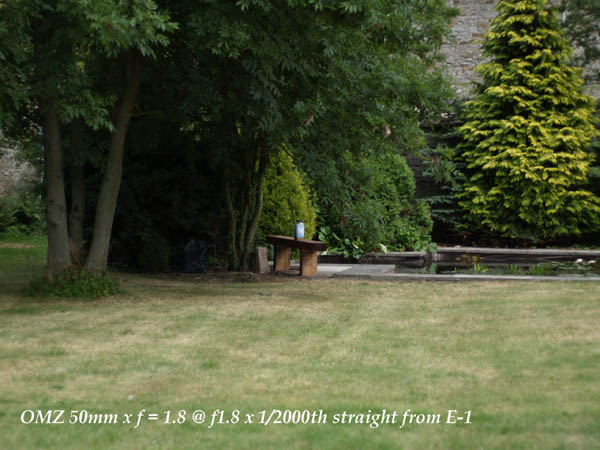
Not bad, a tad soft. Much depends on the individual lens. Mixed results. | |
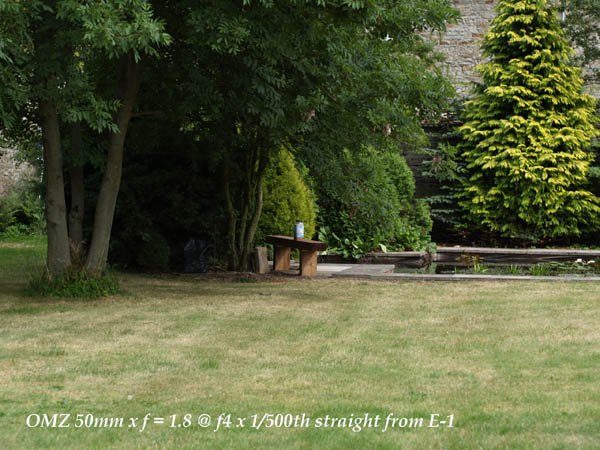
Improving and OK ish. I've got mixed feelings about 'standard lenses'. CA not bad at all. | |
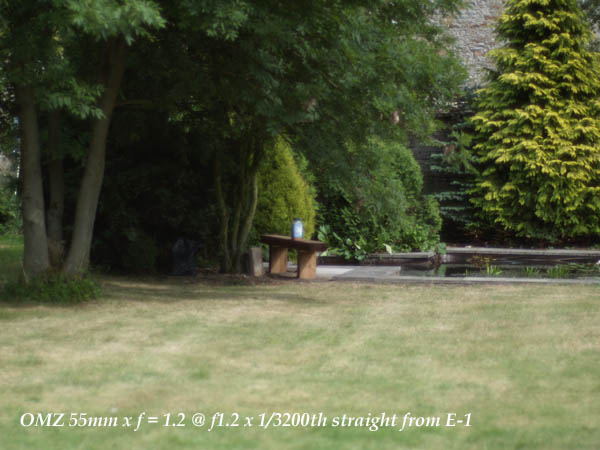
One of my favourite OMZ's. What a pity; this is just awful! It'll have to stay on the 4Ti. | |
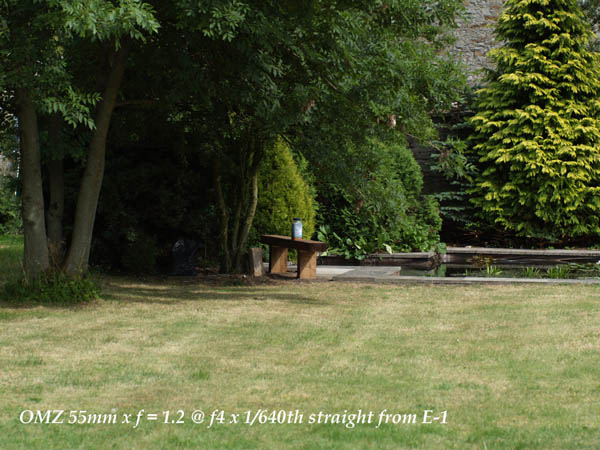
What a turnaround. Too much the other way now - plasticky. Strange. Back to the 4Ti with you. Is this the result of 'earth elements'? Any reader with information please contact me. ~~~~~~~~~~~~~~TELEPHOTO - 85MM TO 300MM~~~~~~~~~~~~~~ | |
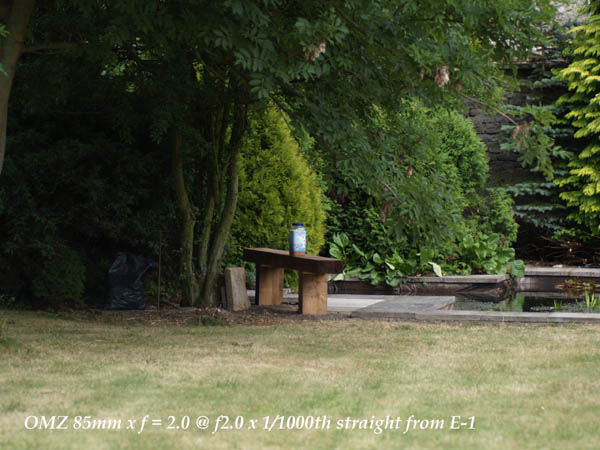
It's not bad; I hoped it would be better. | |
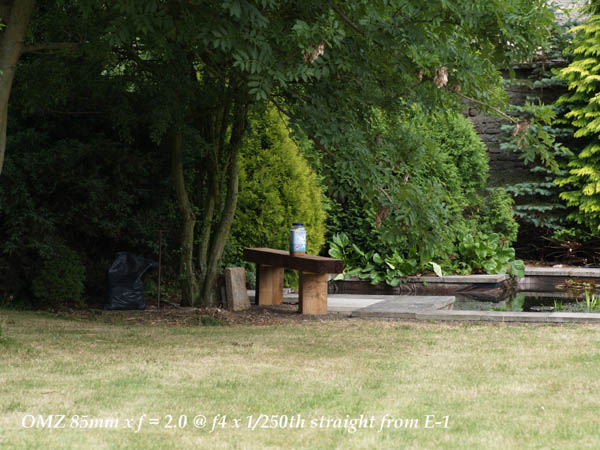
I suppose I could use this lens. It's got potential. I need to practice. | |
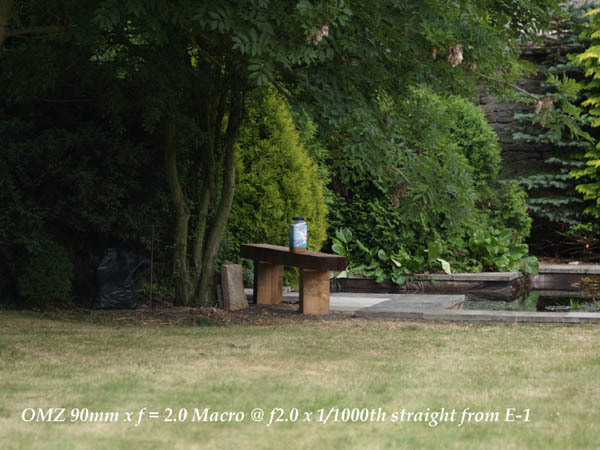
I'm including this all-rounder as a tele here. It just keeps amazing me. Great result. | |
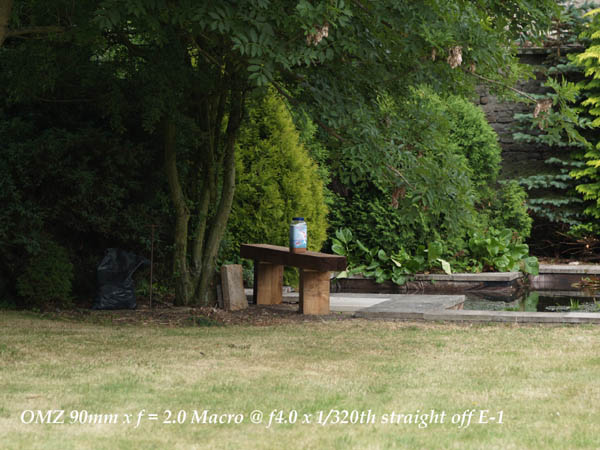
As a Macro lens this is King. Excellent all-rounder. If this is the only OMZ you buy, do so. Recommended. | |
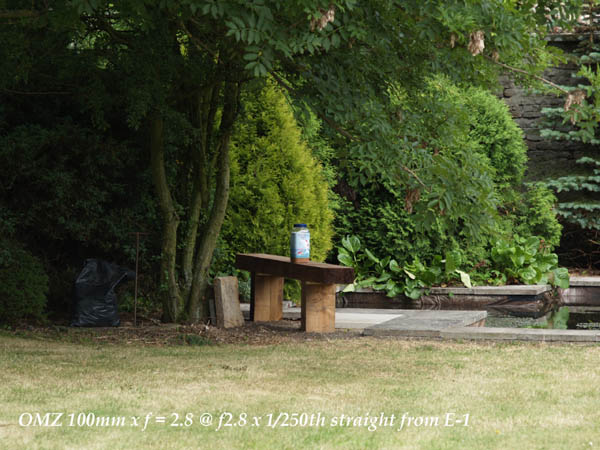
Nice wide open, that means it makes it on to my list! Recommended. | |
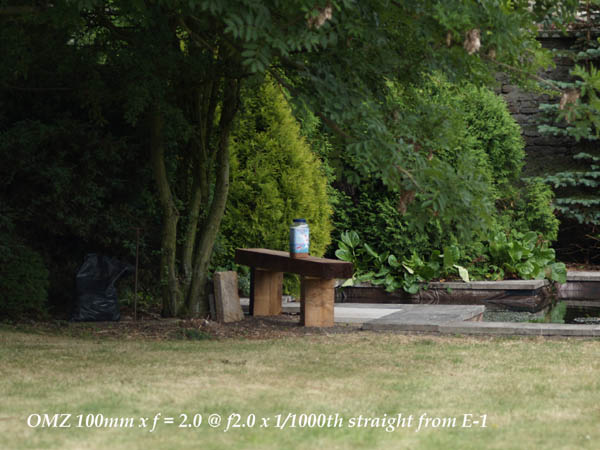
Excellent wide open. Up with the leaders. But this lens is so heavy! | |
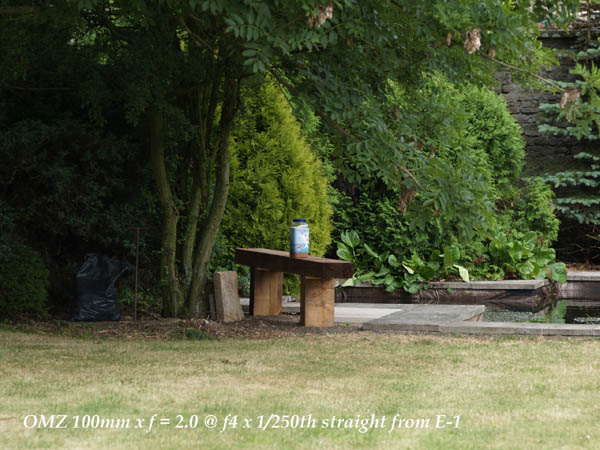
Sharper, lovely colours, consistent. I like everything but the weight. Have the ED elements in this lens cured the exposure problems? | |
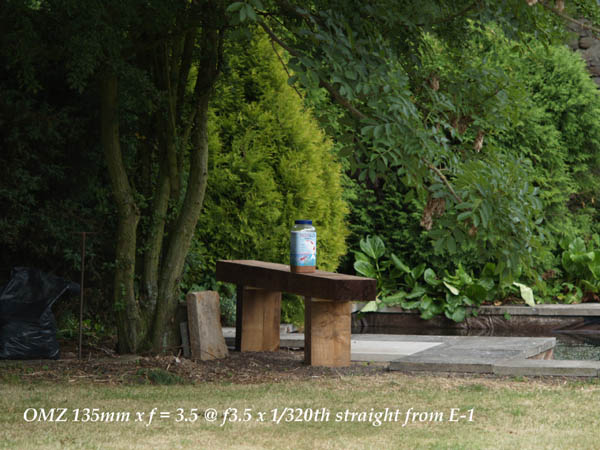
The humble and cheap 135mm tele. Excellent. Highly recommended. | |
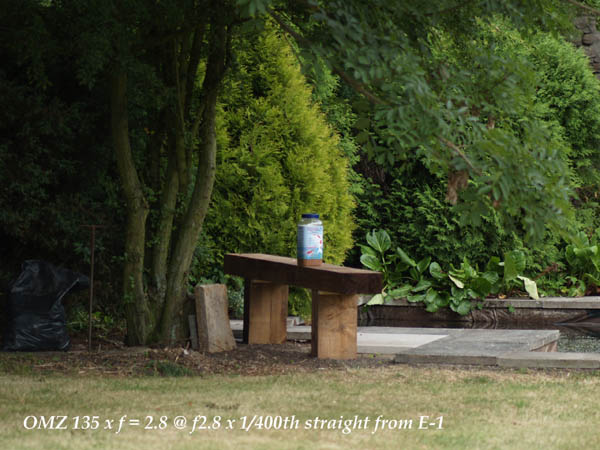
Only a tad softer, still very acceptable with nice bokeh. | |
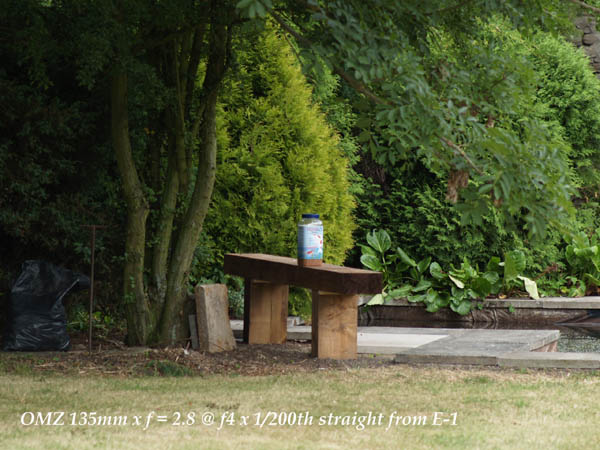
Very, very nice indeed. Either 135mm will serve you well. Recommended. | |
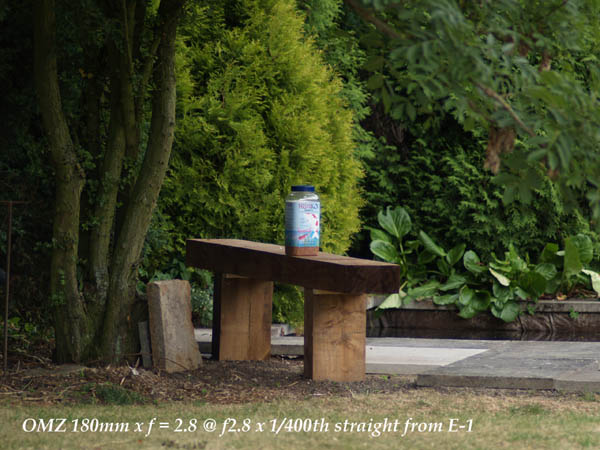
Good, but is prone to horrendous CA - be warned.. | |
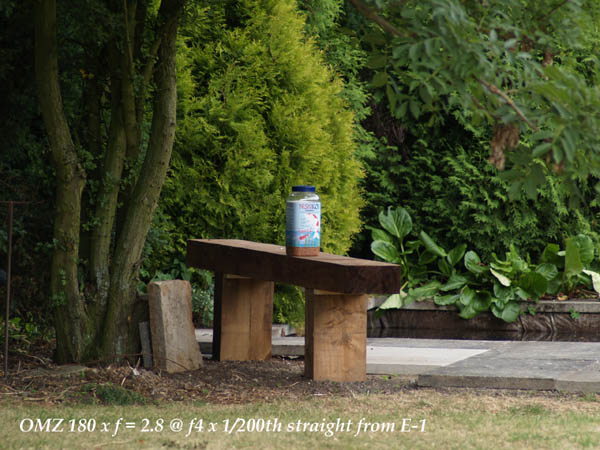
Gets better doesn't it? Big and heavy. My view - stay clear of this one. | |
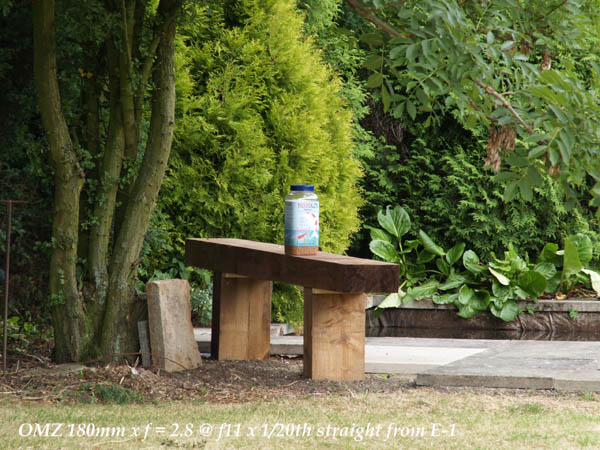
Notice the sudden over exposure? Most tele's do it. | |
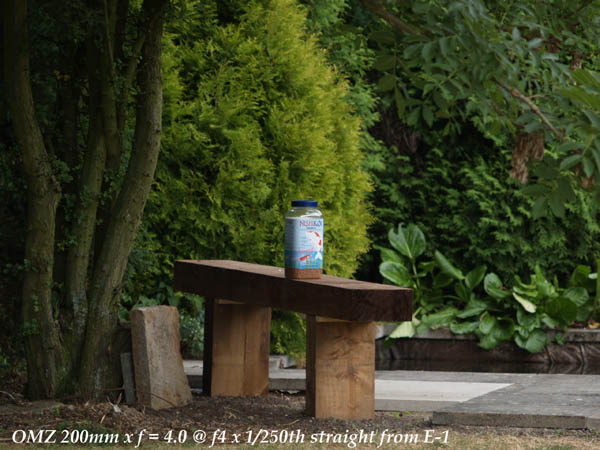
The ubiquitous OMZ 200mm f4 is a fine performer wide open. A 400mm f4 for £60? Only marginally slower than ZD 50-200. Bargain. | |
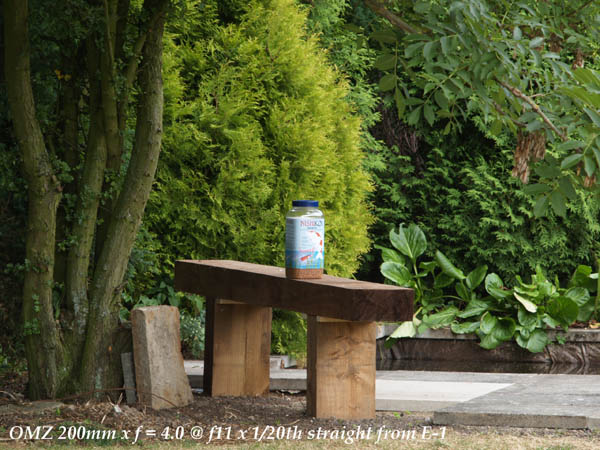
Again see the increase in exposure as the aperture reaches f11? No other problems though. Recommended. | |
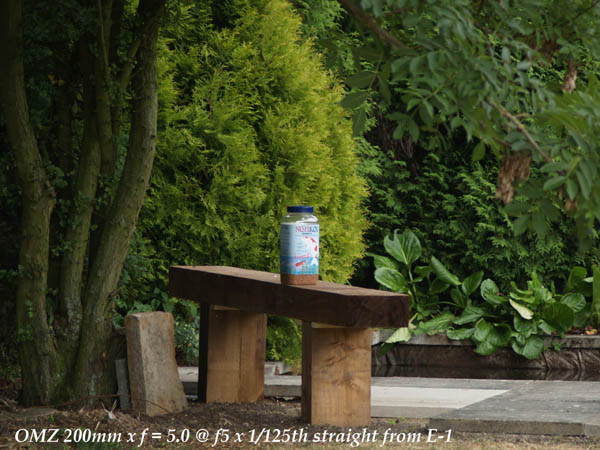
This f5 tele is significantly smaller than the f4 version and an excellent performer. | |
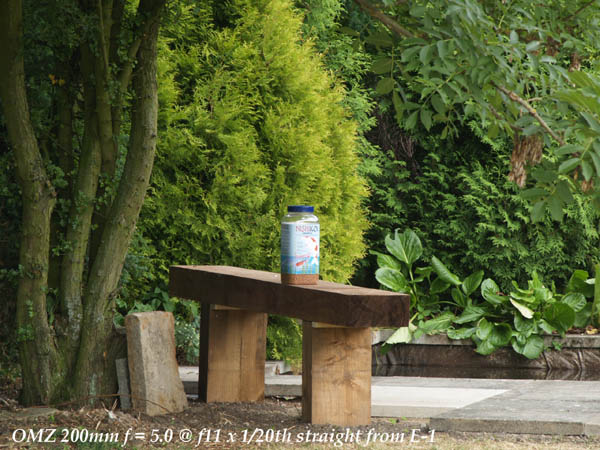
Again the exposure increase at f11, though not problematical. A good lens if you can find one. Recommended. | |
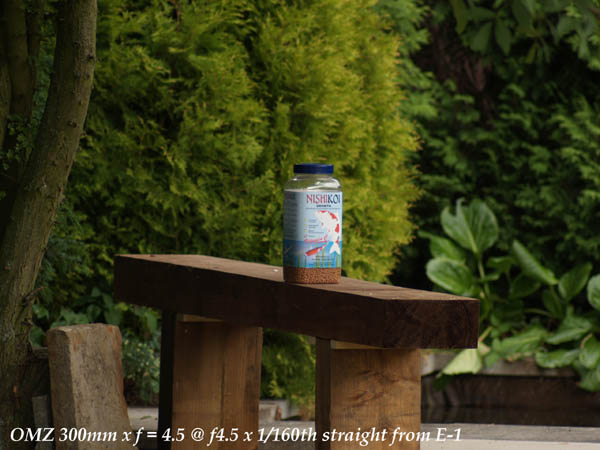
Nice. Needs a bit of post processing, but nothing bothersome. | |
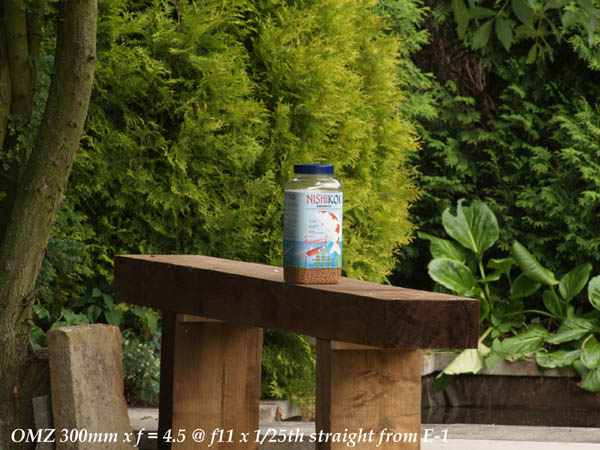
The exposure increase is about right here. Lovely result straight from camera. Recommended. ~~~~~~~~~~SUPER TELEPHOTO - 400MM UP~~~~~~~~~~ | |
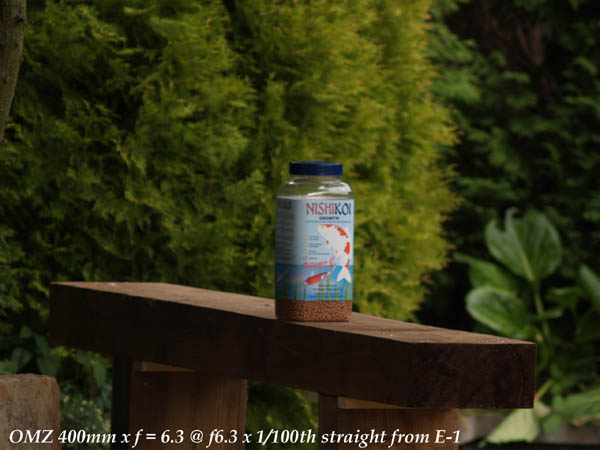
My 400mm is about 30 years old. I reckon this is pretty good. The slightest tad soft. | |
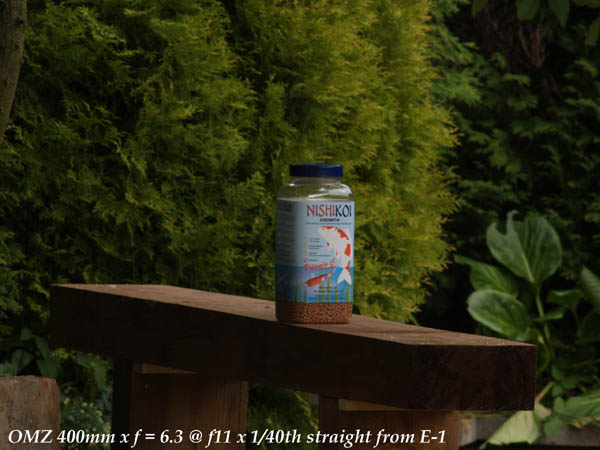
No dramatic exposure changes here but it has sharpened up well. Downside - a huge/heavy lens that must be tripod mounted. | |
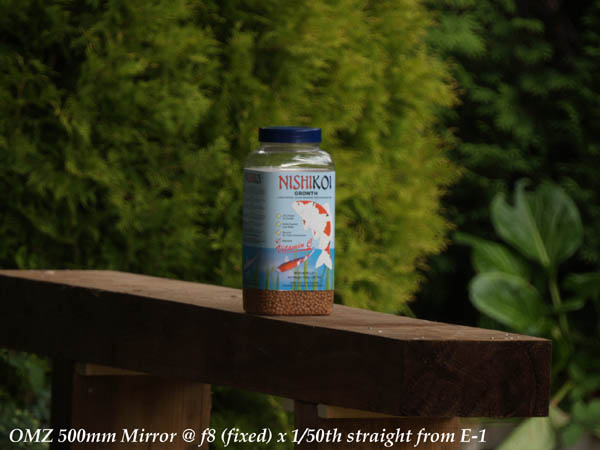
Needs a little post processing but its native sharpness is excellent. I've had nothing but good results from this lens. Recommended. FOOTNOTE This was a quite demanding and time consuming task. I was going to repeat this with OMZ zooms but my experience with them so far leads me to think they are not really a viable option on the E-system. I'll return to this subject at a later date so keep watching. I will be undertaking a similar exercise for the OMZ Macro lenses soon, as without doubt, the OMZ Macros are superb on the digitised bodies. Testing my OMZ primes was one of the first things I did when I bought my machine last year, but I had to abandon the project due to my wayward E-1 kit. However, it's done now and whilst not perfect I hope it gives you some useful pointers.
RECOMMENDATION Having spent considerable time using OMZ's on my E-1 here's FIVE simple recommendations: Practice! Use CW metering in A or M mode. Spot tends to compound exposure miscalculation. ESP is useless. Apply -1/3rd or -2/3rd compensation. Avoid use fully open if you can. Use between stop two (lens dependent) and f8 only. If it's important shoot RAW + jpeg.
FURTHER OBSERVATION 1. WIDE-ANGLE: I don't agree with Olympus that light fall-off occurs in all their wide-angle lenses. The 8mm of course, the 16mm sometimes, the 18mm maybe, but the rest no. Even so, with any of the super wide-angle lenses careful use produces quite acceptable results. By far the greater problem lies in the E-1's auto-exposure calculations when these lenses are fitted. It tends to be a bit flaky to say the least. In general there is over-exposure wide open becoming reasonably accurate in the low to mid range with over-exposure occuring once more at around f11 and higher. However, with a bit of experimentation and a wise eye you can easily overcome this. You will also notice that there can be a minor colour cast issue too. Again, nothing dramatic; nothing you can't put right in PS. My advice to anyone wanting to use the wide-angle end of OMZ's is simple. Play with them first, see how good or bad your E-system camera responds to them, make adjustments to your method and where appropriatre shoot RAW+jpeg. The second issue I have with the OMZ SWA's and WA's is CA. It seems to pervade certain focal lengths but is kind to others. The 28mm range is particularly plagued yet 24mm is relatively free of CA. And results can differ between lenses of the same focal length. As a general pointer avoid fast WA's, make do with the 'ordinary' versions as these are far superior both in native sharpness and less CA. At some focal lengths Olympus made 'budget' variations - 28 & 35mm x 3.5's for example. These are naturally sharper and even less prone to CA than their siblings. I find it ironic to have to move from super-fast lenses for analogue machines to dog-slow ones in the transition to digitisation of my favourite hobby! 2. STANDARD: I find the OMZ range of standard lenses are a waste of time. From 40mm to 55mm (80mm to 110mm equivalent) - no one wants these as 'standard' lens and the range is nicely covered by the standard 14-54 (28-108) anyway. Portrait lenses? Well maybe, but they are, frankly, too sharp for portraiture (maybe the 55mm x 1.2 is the exception, but only wide open). 3. TELEPHOTO: The medium to super telephoto OMZ's are generally very good to simply excellent. And again it seems the cheap, humble and ubiquitous lenses offer better results than the 'arm & leg' brigade. There are exceptions to this; the expensive 90mm Macro and 100mm x f=2.0 are superb. As for the 600mm & 1000mm I've not managed to add them to my OM collection and if I'm going to be using the E-system more than OM I probably won't be looking very hard. The 400mm is bad enough in use, never mind anything longer. It's a pity I don't have any of the 'Big Whites' from Olympus. Based on my observations to date I suspect these may be useless on an E-1, although they are blessed with ED elements like the 100mm x f2.0 that might cut down on CA. Perhaps a reader can enlighten the rest of us.
I've been contacted by such a lucky owner of two such lenses who maintains his 'big whites' on the E-1 produce extremely good images being sharp and virtually free from CA. I'm awaiting some sample shots from him to share with readers.
GENERAL Don't forget you need to use OMZ's in 'stop down' mode. This means the aperture is permanently and mechanically linked to the aperture ring. If you mount an OMZ with its aperture ring set at f16 the image you see in the viewfinder is f16 - very dark - making critical focus difficult/impossible. You must turn the OMZ aperture ring LEFT to its lowest number thus providing plenty of light on the ground glass focusing screen. After you've focused turn the ring to the RIGHT by at least one click (or more) closing the aperture a little to ensure good AE and then make your exposure. If you are regularly using OMZ's on the E-1 you'll quickly get into this habit. As a workaround I tend to leave the OMZ's I most use set at f4 - this gives enough light to focus by, ensures an accurate AE and for the most part negates the need to 'stop down.' There is a definate tendency for the E-1 to over-expose with OMZ's mounted. It's not much but enough to spoil the shot. As a general rule I set the camera to minus one or two thirds compensation for all shots with OMZ's. This way the camera protects the highlights and you can adjust it in post processing. Whether it's one or two stops is up to you. Checking the monitor after each shot, for me anyway, is not viable. Of no real concern to your use of OMZ's is the interesting fact that they will all focus beyond infinity. This must be due to an optical mismatch between the 35mm designed lens on the digital designed body. As you are focusing through the lens anyway it is largely irrelevant. One of my visitors, a physicist, informs me that the reason for this 'beyond infinity' focus is the OM to E-system adapter is not the correct thickness, being 0.10mm too thin. This error is more noticable with SWA and WA lenses. For most purposes this is of no consequence but it makes the static setting of hyperfocal distance with wide and super-wide angle lenses impossible because we don't know where infinity is on the ring. The Rule: the wider the lens the greater the infinity error. Indeed I tested my OM 8mm and found that when focussed at infinity the read-out scale indicated 1.2ft - that's a lot of error. As said the problem gets less as the FL increases and is of no consequence at FL's of 24mm and above.
E-SYSTEM SUPPLEMENTARY GLASS? For anyone with a collection of OMZ glass all is far from lost. They can nicely supplement the ZD zooms and provide a realistic alternative to the hugely expensive ZD fast primes. If like me you are not a great lover of zooms (though I admit I'm warming to the ZD's) OMZ primes can provide you with that 'retro' feeling of actually having an input into your photographs. If you are blessed with good eyesight the manual focusing of the OMZ telephoto's is, in my opinion, better than the ZD's AF. For those without OMZ's who fancy a few supplemental lenses I recommend some or all of these: 21mm x f3.5 or 24mm x f2.8 as a 'standard' lens. An older (softer the better) OM 50mm x f=1.4 standard lens for portraiture only. 100mm x f2.8 135mm x f3.5 or 200mm x f4 or f5 300mm x 4.5 or 500mm x f8 Mirror 2XA converter for use with the above. This provides a manual lens range of (equivalent) 42mm to 1200/2000mm. If you buy sensibly and over several months you should manage a nice little collection for £400 - £600 (or less) dependent on your choice and based on current prices. I recommend only Olympus Zuiko's. This is an excellent way to re-cycle, saving resources and money. Get them - before they simply disappear.
If you have any observations please contact me here.
| |
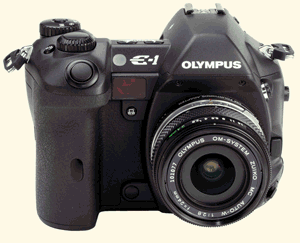
E-1 fitted with OMZ 24mm x 2.8 as a 'standard' lens.
| |
|
| |
|
|
|
HOME |
INTRO |
BOOKS |
OLYMPUS CIRCLE |
QUEST |
TOC MEMBERS |
GALLERIES
|
| Posted July 2005 14:04 | Copyright © 2005 John Foster |